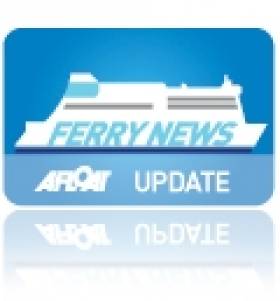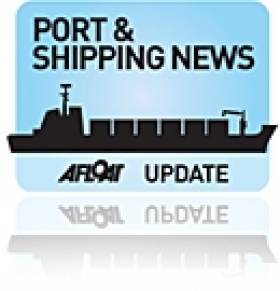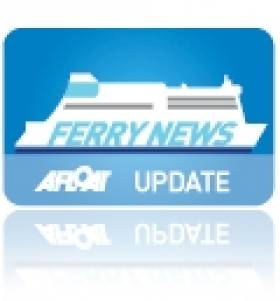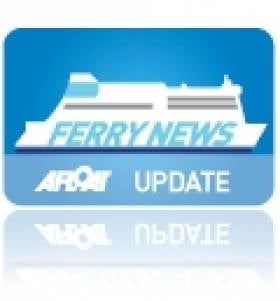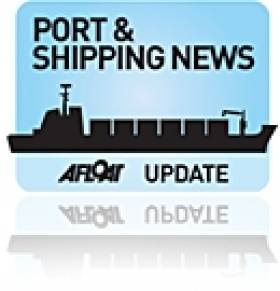Displaying items by tag: ICG Group
Revamped Chartered Irish Ferry Returns to New Zealand Service
#InterIslander- The flagship Interislander ferry Kaitaki has returned to Nez Zealand waters following a $4.5 million face-lift, writes the Dominion Post.
As previously reported on Afloat.ie, the charter of the Irish Continental Group 1,650 passenger car ferry Kaitaki had departed Wellington for Brisbane just over six weeks ago for dry dock work and for a significant upgrade to its passenger areas.
The maintenance work was carried out on its hull, tailshafts, stabilisers and decks. Parts of the 182-metre-long ship were also repainted.
Interislander general manager Thomas Davis says it was a logical decision to also revamp certain areas on the ship after its lease was renewed for another four years in May.
#FerryCharter- New Zealand ferry operator Interislander has announced the renewal of the charter lease of Irish Continental Group's (ICG) ferry Kaitaki for another four years, writes Jehan Ashmore.
ICG which are the parent company of Irish Ferries, have chartered out the Kaitaki, (the former Irish Sea ferry Isle of Innisfree) to Interislander since 2005 and where the 22,365 tonnes ro-pax operates on the scenic north-south islands route between Wellington and Picton.
The voyage along the 92km distance long route takes 3 hours to complete across the Cook Strait and has been described as "one of the most beautiful ferry rides in the world".
The agreement by ICG to extend the bare boat charter of Kaitaki, to KiwiRail Limited trading as Interislander is a direct continuation from the current charter, which was due to expire on 30 June 2013 and where over the next four years, the annual charter rate is €3.75m.
Kaitaki which is the Maori translation for Challenger, is the flagship of the Interislander fleet and is the largest passenger ferry (with a 1,650 capacity) operating in New Zealand waters.
She has proved to be a valuable member of the fleet where freight levels have reached of up to 60 trucks transported on nightly sailings and to a lesser extent during day-time sailings. In addition the route provides time sensitive perishable goods deliveries between the islands.
Under the charter terms the agreement also provides for an option for Interislander to extend the charter beyond July 2017 for a further period of three years and at a reduced rate.
Originally the Dutch built ferry started a career as Isle of Innisfree, the first custom-built ferry for Irish Ferries, when introduced onto Dublin-Holyhead service in 1995.
Notably Isle of Innissfree's debut not only marked modernisation but investment confidence on the central corridor route which was part of B&I Line operations until ICG acquired the ailing state-owned company several years previously.
Further business accelerated on the Dublin route which led to a larger newbuild Isle of Inishmore enter service in 1997 and in which displaced the 'Innisfree' to Rosslare-Pembroke Dock route.
In turn 'Inishmore' was replaced and also transferred to the southern corridor route upon introduction of the giant new 'flagship' Ulysses in 2001.
With Isle of Innisfree having no role anymore on the Irish Sea in that year, she was laid up until 2002 when ICG chartered the ferry to P&O Ferries. As the renamed Pride of Cherbourg she ran from her namesake port to Portsmouth.
Following English Channel service the 550 car-capacity ferry then spent a stint in the Baltic Sea as Stena Challenger before heading for her current role in the southern hemisphere.
Irish Continental Group Statement of Results for 2012
#Shipping – The Irish Continental Group (ICG) parent company of Irish Ferries, have released a statement of results for the year ended 2012.
Commenting on the results Chairman John B McGuckian said,''These are resilient results in the face of a challenging economic background. There is now some emerging evidence of an improvement in the Irish economic environment, but we remain cautious, particularly in relation to freight capacity.''
ICG produced another resilient performance in the face of continued economic weakness, which affects both consumer travel and import / export trade flows, the two areas of economic interest for the Group.
During the year the group announced, and completed, the sale of its subsidiary Feederlink. Consequently the results for the group's continuing operations (i.e. excluding Feederlink for both 2012 and 2011) are set out below.
Revenue for the year from continuing operations was up 1.7% at €256.1 million while continuing EBITDA1 was down 3.2%, to €45.8 million, due mainly to lower freight volumes in both Ro-Ro and Lo-Lo and higher fuel costs (up €6.3 million to €53.2 million) largely offset by higher yields in the passenger business.
The net interest charge was €1.8 million (2011: €1.0 million) before a net interest expense from defined benefit pension schemes of €1.6 million (2011: credit of €0.3 million). The taxation charge was €0.5 million compared with €0.8 million in 2011.
The profit on sale of Feederlink was €21.0 million. Basic EPS including the profit on sale of Feederlink was 183.2 cent while adjusted EPS from continuing operations was 104.6 cent, up 3.1%.
For further information of the statement of results, click HERE for PDF download.
Irish Continental Group Release Financial Interim Report 2012
#PORTS & SHIPPING - Below is a comment from John B. McGuckian, chairman of the Irish Continental Group (ICG) on the half-yearly financial report for the six months ended 30 June 2012.
Mr. McGuckian said, "I am pleased to report a robust performance in the first six months of the financial year. Turnover grew, albeit moderately while EBITDA was €14.3 million in the first six months of the year, down only €1.8 million despite an increase of €4.5 million in our fuel bill in the period.
With regard to current trading, while freight remains weak due to the economic background our tourism and car business has benefited from reduced competitor capacity although fuel costs remain a headwind.
With our strong cash flow and balance sheet we propose an unchanged interim dividend of 33 cent per ICG Unit and due to the strength of our capital position propose a return to shareholders of up to €111.5 million via a tender offer buy-back, which is subject to shareholder approval.‟‟
Interim Management Report for the six months up to 30 June 2012
Results
The Board of Irish Continental Group plc (ICG) reports that, in the seasonally less profitable first half of the year, the Group recorded revenue of €127.1 million compared with €126.6 million in the same period in 2011 an increase of 0.4%.
Earnings before interest tax and depreciation (EBITDA) were €14.3 million compared with €16.1 million in the same period in 2011.
Operating profit was €5.1 million compared with €6.5 million in 2011. Group fuel costs were €28.9 million compared with €24.4 million in the same period in 2011. There was a net finance charge of €1.2 million (2011: €0.3 million) which includes a net pension expense of €0.8 million (2011: credit of €0.1 million) and net bank interest payable of €0.4 million (2011: €0.4 million).
Profit before tax was €3.9 million compared with €6.2 million in the first half of 2011. The tax charge amounted to €0.3 million (2011: €0.1 million). Basic EPS was 14.5c compared with 24.4c in the first half of 2011. Adjusted EPS (i.e. before the net pension interest expense) amounted to 17.7c (2011: 24.0c).
Dividend
The Board declares an interim dividend of 33 cent per ICG Unit payable on 5 October to shareholders on the register at 21 September 2012.
Disposal of Subsidiary
On 29 August 2012 the Group entered into an agreement for the sale, subject to regulatory approval, of its subsidiary Feederlink Shipping and Trading b.v. for a consideration of up to €29 million. All details are available from clicking this link: http://www.icg.ie/documents/2012/2012-07-30-Half-Year-Results.pdf
Rising Costs Scuttle ICG's Ferry Profits
#FERRY NEWS – The Irish Continental Group (ICG) operators of ferry division Irish Ferries, said today its pre-tax profit for last year fell by 30 per cent to €28.2 million on the back of higher fuel costs, reports The Irish Times.
Despite the tough trading conditions, the group said it revenue for 2011 rose by 4.2 per cent to €273.3 million. Irish Ferries saw its passenger numbers for the year fall marginally by 0.7 per cent to 1,527 million, while its roll-on roll-off freight rose up by 9 per cent.
The company said the extremely challenging economic circumstances in the Republic contributed to the lack of growth in the market, and the pressure on operating costs for our freight customers remained intense.
Chairman John B McGuckian predicted the current year would remain challenging as fuel costs have further increased but with the group's "disciplined approach to capacity" he said he was confident of its prospects.
In the year to date, the ferry operator has carried 31,100 cars, down 8.5 per cent on 2011 and 138,600 passengers, up 0.8 per cent on 2011.
The reduction in car carryings partially reflects an 11 per cent reduction in sailings in the year to date but also a quieter than expected start to the year, it said.
Former B+I Line Freight-Ferry Bound for Turkish Breakers
#FERRY NEWS-P&O Irish Sea's Larne-Troon freight-ferry Norcape (14,087grt) departed the Co. Antrim port last week to be broken-up at ship-breakers in Aliaga, Turkey. She originally served B+I Line as the Tipperary, but her last sailings took place on the North Channel in late November, as the ageing vessel is in her fourth decade of service, writes Jehan Ashmore.
The 125-trailer capacity ro-ro was not replaced on the single-ship operated route which closed for the winter months, though sailings will resume next March by the 92m fast-ferry Express. In the meantime freight traffic will be accommodated on the companies Larne-Cairnryan service.
Yesterday morning Norcape transitted the Strait of Gibraltar having called en-route to Falmouth several days previously. She represented the last vessel to serve in Irish waters with a direct link to B+I Line, the state-owned operator which was sold in 1992 to ICG, parent company of Irish Ferries.
When she arrives in Aliagra, this is where her former P&O fleetmate European Mariner (5,897grt) was scrapped after also serving Larne-Troon sailings until last July. Norcape entered the North Channel route replacing the smaller 53-trailer capacity vessel.
Prior to then Norcape had been in laid-over in Liverpool docks when European Endeavour replaced her in February on the Dublin-Liverpool route. To read more click HERE.
Norcape's return to the Irish Sea service in 2009, reflected her original career for P&O. She was named Puma in 1979 from the Japanese shipyard at the Mitsui Engineering & SB Co Ltd, Tamano, however she was chartered to B+I Line and renamed Tipperary. To read more and to view a deck-drawing profile, click HERE.
Her career started with a new Dublin-Fleetwood route jointly operated with P&O, who contributed with a sister, the Ibex. The P&O brand name Pandoro stood for P and O Ro, their roll-on roll-off freight division. The route's UK port switched to Liverpool in 1988 with Tipperary remaining on the route until sold to North Sea Ferries in 1989 and renamed Norcape.
Before her transfer to the North Sea, Tipperary collided with the 4,674grt bulker Sumburgh Head off the entrance to Dublin Port in 1988. Incidentally the two vessels, under different names and ownership were in Dublin Port in 2010, as previously reported (with photo) click HERE.
- Ports and Shipping News
- Norcape
- P&O (Irish Sea)
- B+I Line
- European Endeavour
- Ferry news
- Irish Sea Ferries
- Irish Sea ferry news
- LarneTroon
- MV Tipperary
- Turkish shipbreakers
- P&O Express
- MV Ibex
- Pandoro
- Aliagra,Turkey
- MV Norcape
- ICG
- ICG Group
- Irish Continental Line
- North Channel ferry routes
- LarneCairnryan
- Irish Ferries
Irish Ferries Win Best Ferry Company
#FERRY NEWS- Irish Ferries has won the 'Best Ferry Company' award at the Irish Travel Agents Association travel industry awards held last night in the Mansion House, Dublin.
This was the thirteenth time that the award has gone to Irish Ferries since the event started two decades ago. The award which was presented on foot of votes cast by travel agents and their staff employed throughout the island of Ireland was accepted jointly by its head of passenger sales Declan Mescall and passenger sales manager Marie McCarthy.
Thanking travel agents for the honour their decision bestows on the company, Mr. Mescall said that the Best Ferry award reflects the high standard of service which passengers can now expect from Irish Ferries.
'In addition, it recognises the numerous developments that have taken place in the company in recent times, including the introduction of class leading advances in electronic communications, the most recent being the introduction of the industry's first bookable smart phone app which was launched just months ago' said Mr. Mescall.
The award follows Irish Ferries parent company Irish Continental Group (ICG) whose Dutch based container division Eucon Shipping and Transport was awarded Short Sea Shipping Company of the Year Award 2011, sponsored by the Irish Maritime Development Office (IMDO).
Eucon operate regular feeder services to Antwerp, Rotterdam and Southampton from the ports of Belfast, Dublin and Cork.
Export Industry Awards to Deep and Short Sea Shipping
Eucon Shipping and Transport Ltd won the Short Sea Shipping Company of the Year Award 2011, sponsored by the Irish Maritime Development Office (IMDO), which recognises the strategically important role of short sea shipping to our economy. Eucon offers Irish exporters access to worldwide markets via its regular feeder services to Rotterdam, Antwerp and Southampton operating from the ports of Dublin, Cork and Belfast. The other nominees were: CLdN RoRo S.A. and Grimaldi Lines.
In the category for the Logistics Company of the Year Award 2011, sponsored by Dublin Port Company, the award went to Caffrey International. The Co. Meath based company is a specialist provider of road transport and logistics services between Ireland, the UK and continental Europe.
The award recognises the importance of logistics and supply chain management firms to the exporting effort of companies trading internationally from Ireland. The other nominees were: DHL Global Forwarding (Ireland) Ltd., Dublin; Eucon Shipping and Transport Ltd. and Geodis Ireland Limited, Dublin.
ABC Nutrition of Shannon was presented with the overall award of the Exporter of the Year Award 2011 after winning in the Emerging Markets Exporter Award, one of twelve categories which were presented at the ceremony.
Irish Continental Group Record 61% Rise in Profit
The Irish Continental Group (ICG) which is the parent company of Irish Ferries, has warned of 'uncertainty' in 2011 due to higher fuel costs and the effects of the austerity measures in both the Irish and UK economies.
ICG secured a 61% increase in pretax profits in 2010 following an increase in passenger numbers and the sale of their MV Pride of Bilbao to St. Peter Line (click here) after a long-term charter to P&O Ferries. The 37,583 gross tonnes cruiseferry is to open a new second route for the Baltic Sea operator between St. Petersburg and Stockholm, starting next month.
To read more about ICG's end of year results, click the report in today's Irish Times.



























